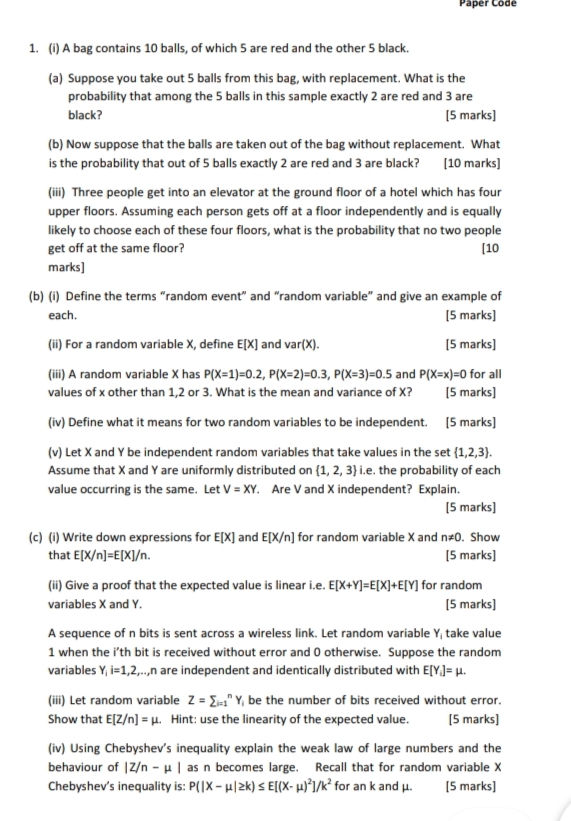THANKYOU
1. (i) A bag contains 10 balls, of which 5 are red and the other 5 black. (a) Suppose you take out 5 balls from this bag, with replacement. What is the probability that among the 5 balls in this sample exactly 2 are red and 3 are black? [5 marks] (b) Now suppose that the balls are taken out of the bag without replacement. What is the probability that out of 5 balls exactly 2 are red and 3 are black? [10 marks] (ili) Three people get into an elevator at the ground floor of a hotel which has four upper floors. Assuming each person gets off at a floor independently and is equally likely to choose each of these four floors, what is the probability that no two people get off at the same floor? [10 marks] (b) (i) Define the terms "random event" and "random variable" and give an example of each. [5 marks] (ii) For a random variable X, define E[X] and var(X). [5 marks] (iii) A random variable X has P(X=1)=0.2, P(X=2)=0.3, P(X=3)=0.5 and P(X=x)=0 for all values of x other than 1,2 or 3. What is the mean and variance of X? [5 marks] (iv) Define what it means for two random variables to be independent. [5 marks] (v) Let X and Y be independent random variables that take values in the set (1,2,3). Assume that X and Y are uniformly distributed on (1, 2, 3) i.e. the probability of each value occurring is the same. Let V = XY. Are V and X independent? Explain. [5 marks] (c) (i) Write down expressions for E[X] and E[X] for random variable X and n=0. Show that E[X]=E[X]. [5 marks] (ii) Give a proof that the expected value is linear i.e. E[X+Y]=E[X]+E[Y] for random variables X and Y. [5 marks] A sequence of n bits is sent across a wireless link. Let random variable Y, take value 1 when the i'th bit is received without error and 0 otherwise. Suppose the random variables Y, i=1,2,...n are independent and identically distributed with E[Y ]= J. (iii) Let random variable Z = Zij" Y; be the number of bits received without error. Show that E[Z] = p. Hint: use the linearity of the expected value. [5 marks] (iv) Using Chebyshev's inequality explain the weak law of large numbers and the behaviour of | Z - u | as n becomes large. Recall that for random variable X Chebyshev's inequality is: P(|X - u| 2k) s E[(X- u)']/k for an k and u. [5 marks]1. (i) A bag contains 10 balls, of which 5 are red and the other 5 black. (a) Suppose you take out 5 balls from this bag, with replacement. What is the probability that among the 5 balls in this sample exactly 2 are red and 3 are black? [5 marks] (b) Now suppose that the balls are taken out of the bag without replacement. What is the probability that out of 5 balls exactly 2 are red and 3 are black? [10 marks] (ii) Three people get into an elevator at the ground floor of a hotel which has four upper floors. Assuming each person gets off at a floor independently and is equally likely to choose each of these four floors, what is the probability that no two people get off at the same floor? [10 marks] (b) (i) Define the terms "random event" and "random variable" and give an example of each. [5 marks] (ii) For a random variable X, define E[X] and var(X). [5 marks] (iii) A random variable X has P(X=1)=0.2, P(X=2)=0.3, P(X=3)=0.5 and P(X=x)=0 for all values of x other than 1,2 or 3. What is the mean and variance of X? [5 marks] (iv) Define what it means for two random variables to be independent. [5 marks] (v) Let X and Y be independent random variables that take values in the set (1,2,3). Assume that X and Y are uniformly distributed on {1, 2, 3) i.e. the probability of each value occurring is the same. Let V = XY. Are V and X independent? Explain. [5 marks] (c) (i) Write down expressions for E[X] and E[X] for random variable X and n=0. Show that E[X]=E[X]. [5 marks] (ii) Give a proof that the expected value is linear i.e. E[X+Y]=E[X]+E[Y] for random variables X and Y. [5 marks] A sequence of n bits is sent across a wireless link. Let random variable Y, take value 1 when the i'th bit is received without error and 0 otherwise. Suppose the random variables Y, i=1,2,..,n are independent and identically distributed with E[Y ]= u. (ii) Let random variable Z = [i" Y, be the number of bits received without error. Show that E[Z] = u. Hint: use the linearity of the expected value. [5 marks] (iv) Using Chebyshev's inequality explain the weak law of large numbers and the behaviour of | Z - u | as n becomes large. Recall that for random variable X Chebyshev's inequality is: P(|X - u| 2k) s E[(X- u) ]/k for an k and u. [5 marks]








